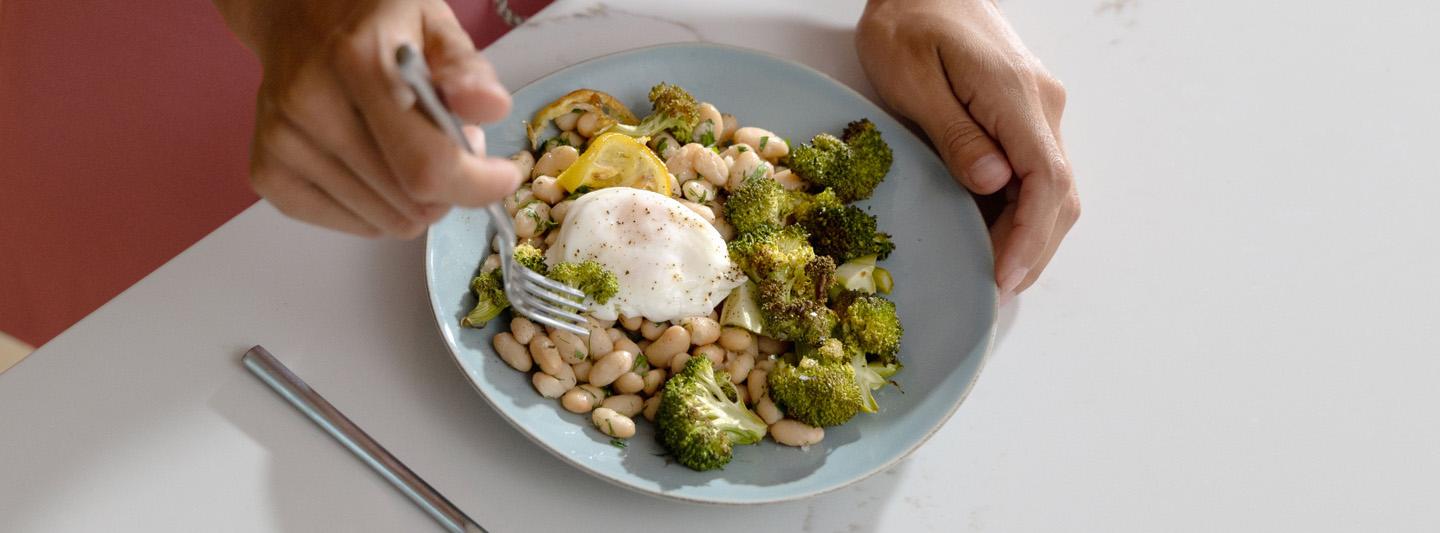Add fibre to fill up and help manage your glucose
Eating fibre-rich foods can help keep your glucose steady throughout the day. Learn more about how to increase your fibre intake here.
Christina Stiehl,
Managing Editor
Pamela Nisevich Bede, MS, RD, CSSD, LD,
Medical Affairs
Published:
April 28, 2025
Read time:
2 minutes

Start Lingo today for just £59
Learn how your body responds to food and exercise with a 2-week plan*, no commitment.
Buy now
The latest UK data shows that fewer than 1 in 10 adults meet the daily recommended fibre intake of 30 grams (g). 1 Vegetables, pulses, nuts, seeds, whole fruits, and whole grains are excellent sources of fibre. So, make sure you include them in every meal.
How fibre helps
Including fibre-rich foods in a meal not only makes it more satisfying 2 but it also helps stabilise your glucose. 3 As your body is unable to absorb and break down fibre, it doesn’t cause a glucose spike.
A review in the British Medical Journal (BMJ) found that including fibre-rich foods was linked with improved glucose control in adults with varying health conditions. The review also showed that increasing your daily fibre intake to 35 g helps improve the risk factors for heart disease, such as cholesterol levels and bodyweight. 4
Five ways to add fibre
Use more pulses. Three heaped tablespoons of beans or chickpeas provides at least 4.5 g of fibre. Add them to your salads and sauces or have them as a side dish.
Opt for wholegrain and seeded bread. A slice of wholegrain bread with avocado provides about 4 g of fibre.
Adding a tablespoon of flax or chia seeds to your salad (or on your soup, salad, or porridge) provides about 3-5 g of fibre.
For a fibre-rich snack, a handful of nuts, seeds, and dried fruit adds about 4 g. A banana or an apple will each add 2 g.
Check the nutrition labels for foods “high in fibre” (6 g per 100 g) or a “source of fibre” (3 g or more per 100 g).
While you’re busy adding fibre, remember to fill up on fluids too. Fibre draws water into the bowel, so drinking plenty of fluids will allow the fibre to do its job properly.
A final note from Lingo
Including good sources of fibre in your meals can help make them more filling as well as creating less of an impact on your glucose levels. If you're not including enough fibre in your diet, look to add some high-fibre plant foods such as leafy greens or lentils where you can.
You can track the effects of fibre on your glucose using a continuous glucose monitor (CGM) like Lingo. These devices provide glucose data that can help you learn which foods might work well for you to keep your glucose steady.
The Lingo system is not for medical use and intended for users 18 years and older. Lingo is not intended for diagnosis or management of any disease including diabetes.
The Lingo programme does not guarantee that everyone will achieve the same results as individual responses may vary. It is best to speak to your doctor for advice on starting any diet or exercise regime or if you have an eating disorder or a history of eating disorders.
© 2025 Abbott. All rights reserved. The biosensor shape and appearance, Lingo, and related brand marks are marks and/or designs of the Abbott group of companies in various territories. Other marks are the property of their respective owners.
ALB-02608
Published:
April 28, 2025
Read time:
2 minutes


Christina Stiehl is the Managing Editor at Lingo. She graduated from the University of Missouri School of Journalism and has more than a decade of professional editorial experience in the health and wellness industry. Christina has written for top media publications including SELF, PS, Shape, Well+Good, Thrillist, and VICE before pivoting to leading content at health tech companies.


Pamela Nisevich Bede, MS, RD, CSSD, LD, is a certified specialist in sports dietetics and an expert in nutrition communications. Pam earned her Bachelor of Science degree in Dietetics from Miami University and a Master of Science in Medical Dietetics from The Ohio State University. While at Abbott Nutrition, Pam was the Global Nutrition Lead at Zone Perfect Nutrition and Ensure and was previously the Manager of Nutrition Marketing at EAS Sports Nutrition.
A healthy choice for your inbox
Sign up for Lingo emails to get science-backed tips, special offers, and The Journey Newsletter.
Start Lingo today
for just £59
Learn how your body responds to food and exercise with a 2-week plan*, no commitment.
- 1 Lingo biosensor with minute-by-minute continuous glucose tracking
- Full access to the Lingo app. Designed for iPhone 11 device or later.
Shop now
Free shipping
*No commitment. This plan does not auto-renew (requires an iPhone 11 or later)

